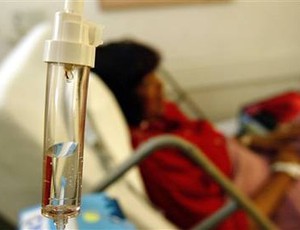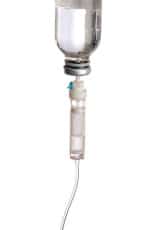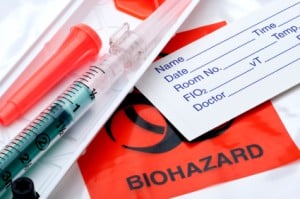Insertion site assessment of peripherally inserted central catheters

The aim of this study was to assess the inter-observer agreement between nurses and patients when assessing a peripherally inserted central catheter site” Webster et al (2018). Abstract: INTRODUCTION: Many patients are discharged from hospital with a peripherally inserted central catheter in place. Monitoring the peripherally inserted central catheter insertion site for clinical and research […]
Effect of pre-filled flush or manually prepared syringes on central venous catheter occlusion and CLABSI

Standardized flushing and single-use prefilled flush syringes are effective in reducing CLABSI rates in PHO patients” Gerçeker et al (2018). Abstract PURPOSE: To compare standardized flushing methods with aseptic non-touch technique; (1) Manually prepared syringes (2) Single-use prefilled flush syringes. METHOD: Forty-eight PHO patients with Hickman or Port catheters were recruited to participate in a […]
Heparin versus normal saline to maintain central venous catheter patency

This study aimed to determine if differences exist in CVC patency, tissue plasminogen activator usage, and the incidence of central line-associated bloodstream infections when flushing with normal saline only versus heparin and normal saline among patients undergoing BMT” Klein et al (2018). Abstract: BACKGROUND: Patients undergoing blood and marrow transplantation (BMT) use a central venous […]
Risk associated with central catheters for malignant tumor patients

We found that PICCs are associated with a raised risk of deep vein thrombosis, and pharmacological deep vein thrombosis prophylaxis drugs is a beneficial factor in decreasing the incidence of thrombosis, while warfarin may decrease the risk of mortality of malignant tumor patients with CICCs” Lv et al (2018). Abstract: The risk of venous thrombosis […]
Intracavitary electrocardiography CVC tip positioning in neonates

We conclude that the intracavitary electrocardiography method is safe and accurate in neonates as demonstrated in pediatric and adult patients” Capasso et al (2018). Abstract: PURPOSE: The neonatologists of Sant’Anna and San Sebastiano Hospital of Caserta have carried out a pilot study investigating the safety, feasibility, and accuracy of intracavitary electrocardiography for neonatal epicutaneous cava […]
Peripherally inserted central catheters in the treatment of children with cancer

Peripherally inserted central catheters are recommend to use in the treatment of children with cancer. There should be trained nursing staff to minimize the risk of complications” Rykov et al (2018). Abstract: PURPOSE: To review our experience with peripherally inserted central catheters in pediatric cancer patients. METHODS: The analysis included 353 patients (3 months up […]
Use of 8-cm 22G-long peripheral cannulas in pediatric patients
Long peripheral cannulas represent a valid option for medium-term intravenous access in children undergoing surgery” Pacilli et al (2018). Abstract: INTRODUCTION: Medium-term intravenous access in children is normally achieved by means of repeated multiple peripheral intravenous cannula insertions or peripherally inserted central catheters. Long peripheral cannulas might offer an alternative to these devices in children. […]
Cardiac implantable electronic device and vascular access recommendations

In patients with end-stage kidney disease requiring vascular access and cardiac implantable electronic device, the best strategy is to create an arteriovenous fistula on the contralateral upper limb for a cardiac implantable electronic device and avoidance of central vein catheter” Kusztal and Nowak (2018). Abstract: For arrhythmia treatment or sudden cardiac death prevention in hemodialysis […]
Risk factors among patients discharged on outpatient parenteral antimicrobial therapy

Here we elucidated the incidence of and risk factors associated with HCU in OPAT patients” Jacobs et al (2018). Abstract: Outpatient parenteral antimicrobial therapy (OPAT) programmes facilitate hospital discharge, but patients remain at risk of complications and consequent healthcare utilisation (HCU). Here we elucidated the incidence of and risk factors associated with HCU in OPAT […]
Mycobacterium neoaurum line related bacteremia

We report the first case of Mycobacterium neoaurum line related bacteremia with concomitant pulmonary involvement” Walayat (2018). Abstract: Mycobacterium neoaurum is a rapidly growing non-tuberculous mycobacterium which is ubiquitous in nature. While it can cause line related infections in immunocompromised host, case reports of urinary tract infections, cutaneous infections, pulmonary infections, and meningoencephalitis have also […]
IV catheter complications in Outpatient Parenteral Antimicrobial Therapy
Debate about whether certain antimicrobial agents traditionally considered vesicants increase the risk of catheter complications has led to uncertainty in venous catheter placement protocols” Keller et al (2018). Abstract: OBJECTIVES: Debate about whether certain antimicrobial agents traditionally considered vesicants increase the risk of catheter complications has led to uncertainty in venous catheter placement protocols. To […]
Use of Lean Thinking to improve infusion occlusion management

This study examined the influence of using Lean Thinking and Six Sigma methodology as a tool in saving hospital money, resulting in better patient outcomes” Steere et al (2018). Abstract: Background: Continual improvement is a necessary part of hospital culture. This occurs by identifying opportunities for improvement that influence efficiency while saving money. Methodology: An […]
Nurses’ compliance with central line associated blood stream infection prevention guidelines

To assess nurses’ compliance with central line associated bloodstream infection (CLABSI) prevention guidelines related to maintenance of the central line and the predictors of compliance” Aloush and Alsaraireh (2018). Abstract: OBJECTIVE: To assess nurses’ compliance with central line associated bloodstream infection (CLABSI) prevention guidelines related to maintenance of the central line and the predictors of […]
Ertapenem administered by subcutaneous or intravenous route in patients with bone and joint infection

Our results indicate that 1 g of ertapenem administered twice daily, by the iv or sc route, may optimize ertapenem exposure and achievement of PK/PD targets in patients with BJI” Goutelle et al (2018). Abstract: Background: Ertapenem is a therapeutic option in patients with Gram-negative bone and joint infection (BJI). The subcutaneous (sc) route of administration […]
Lactate POCT in mobile intensive care units for septic patients

We evaluated if the StatStrip Xpress Meter, a Lactate point of care testing (POCT) handled device, could be a valuable tool in the mobile intensive care units (MICU) to assess the severity of septic patients” Léguillier et al (2018). Abstract: AIM OF THE STUDY: We evaluated if the StatStrip Xpress Meter, a Lactate point of […]
Cost effective treatment of Upper Extremity Deep Venous Thrombosis

The clinical results of the treatment of UEDVT with CDT or PMT were similar. However, PMT required shorter hospital stay and less intensive surveillance, leading to lower total costs” Mahmoud et al (2018). Abstract BACKGROUND AND AIMS: We compared the immediate and one-year results as well as total hospital costs between catheter-directed thrombolysis (CDT) and […]
Prevention of neonatal and pediatric central line-associated bloodstream infection

A centralized CLABSI prevention bundle can universalize central line care, simplify infection control, and improve quality of care to help sustain low CLABSI rates throughout the hospital” Savage et al (2018). Abstract: Purpose: Hospitals devote significant resources developing protocols to minimize the incidence of central line-associated bloodstream infections (CLABSIs), a source of increased patient morbidity […]
Decreasing bloodstream infections related to peripheral intravenous catheters

Using a PIV maintenance bundle including disinfecting caps and tips can effectively lower the rate of primary bloodstream infections attributable to PIV lines” Duncan et al (2018). Abstract: Background: Peripheral intravenous catheters (PIVs) have been considered as having lower risk of infection than central lines. However, research is limited regarding numbers of primary bloodstream infections […]
Evaluation of Alteplase 1 mg for the restoration of occluded central venous access devices

It is beneficial to use 1 mg alteplase for occluded CVADs. The cost of waste is nominal compared with the cost savings for the institution” Jafari et al (2018). Abstract: Background: Alteplase is a recombinant tissue plasminogen activator that is approved for the treatment of occluded central venous access devices (CVADs) and is commercially available as […]
Tunneled-cuffed central catheters in patients with cancer
The focus of this prospective observational research was to study the various indications for Hickman catheter in different solid and hematologic malignancies as well as the various complications and outcomes in pediatric and adult cancer patients” Madabhavi et al (2018). Abstract: Background: Effective and reliable venous access is among the cornerstones of modern medical therapy […]
Parenteral nutrition at home in adult patients with chronic intestinal failure

This study describes the incidences of CRCs in an adult IF cohort over 40 years. It illustrates the evolution and consequences of CRCs, their association to demographic characteristics, and potential risk factors in an effort to provide the rationale for preventive precautions to the relevant patients with IF at risk” Brandt et al (2018). Abstract: […]
Identifying patients at increased risk of central venous catheter dysfunction

The present study was designed to determine risk factors associated with requirement of tPA for CVC dysfunction and to assess the clinical impact of CVC dysfunction in terms of CVC loss and venous thrombotic events (VTE)” MacLean et al (2018). Abstract: Background: Central venous catheter (CVC) dysfunction is a common complication among pediatric cancer patients. […]
Blood gas laboratory location and accuracy of ED lactic acid samples
To investigate an association between blood gas laboratory location and accuracy of ED lactic acid samples” Brazg et al (2018). Abstract: Importance: Emergency Physicians often rely on Lactic Acid (LA) values to make important clinical decisions. Accuracy of LA values improve when blood gas analysis is performed in the emergency department (ED) as opposed to […]
Vitamin-C pharmacokinetics in critically ill patients

Early high-dose intravenous vitamin-C is being investigated as adjuvant therapy in critically ill patients, but the optimal dose and infusion method are unclear” de Grooth et al (2018). Abstract: BACKGROUND: Early high-dose intravenous vitamin-C is being investigated as adjuvant therapy in critically ill patients, but the optimal dose and infusion method are unclear. The primary […]
Principles of non-invasive and invasive methods of arterial blood pressure measurement

This article reviews the physical principles of both non-invasive and invasive methods of arterial blood pressure measurement” Thomas and Rees (2018). Abstract: The accurate measurement of a patient’s arterial blood pressure is vital as it enables clinicians to deliver safe and appropriate care. Blood pressure is a key measurement of haemodynamic status and is a […]
Review of central venous pressure and pulmonary artery pressure monitoring
Central venous pressure and pulmonary artery pressure are used as measures of cardiovascular filling” Gilbert (2018). Abstract: Central venous pressure and pulmonary artery pressure are used as measures of cardiovascular filling. While pressure–volume relationships are not constant, trends in central venous pressure give an indication of increasing or decreasing right ventricular filling, while pulmonary artery […]
Spontaneous correction of the misplaced tip of a peripherally inserted central catheter

The purpose of the present study was to examine a new protocol involving the spontaneous correction of the misplaced tip of a peripherally inserted central catheter (PICC)” Chen et al (2018). Abstract: The purpose of the present study was to examine a new protocol involving the spontaneous correction of the misplaced tip of a peripherally […]
Perceptions of hand hygiene and protective glove use among patients and health care workers
This study investigated differences in perceptions of hand hygiene and protective glove use among patients and health care workers (HCWs) in Poland” Wałaszek et al (2018). Abstract: This study investigated differences in perceptions of hand hygiene and protective glove use among patients and health care workers (HCWs) in Poland. We conducted a survey using an […]
Article explains the principles of Doppler ultrasound and the interpretation of common artefacts
Ultrasound is a form of non-ionizing radiation that uses high-frequency sound waves to image the body. It is a real-time investigation which allows assessment of moving structures and also facilitates measurement of velocity and directionality of blood flow within a vessel” Powles et al (2018). Abstract: Ultrasound is a form of non-ionizing radiation that uses […]
Using a premeasured length technique for central venous catheter tip placement
The carina is located in the mid-zone of the superior vena cava (SVC) and is considered a reliable landmark for CVC placement in chest radiographs” Kwon et al (2018). Abstract: Subclavian central venous catheterization is a common procedure for which misplacement of the central venous catheter (CVC) is a frequent complication that can potentially be […]

